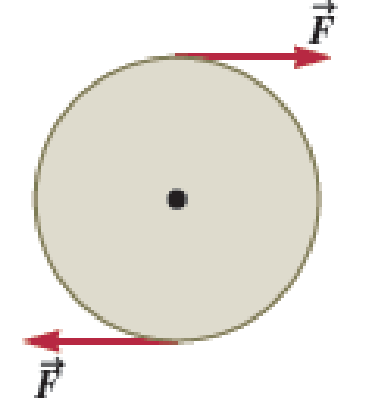
Concept explainers
A uniform disk of mass m = 10.0 kg and radius r = 34.0 cm mounted on a frictionless axle through its center, and initially at rest, is acted upon by two tangential forces of equal magnitude F, acting on opposite sides of its rim until a point on the rim experiences a centripetal acceleration of 4.00 m/s2 (Fig. P13.73). a. What is the

FIGURE P13.73
(a)
Angular momentum of the disk.
Answer to Problem 73PQ
Angular momentum of the disk is
Explanation of Solution
The disk in the question rotates about an axis passing through the center of the disk. Also the axis is perpendicular to the surface of the disk.
Write the equation to find the moment of inertia of the disk about an axis passing through its center.
Here,
Write the equation to find the centripetal acceleration felt by the disk.
Here,
Write the equation to find the linear speed.
Here,
Substitute equation (III) in (II).
Rewrite equation (IV) to get
Write the equation to find the angular momentum of the disk.
Here,
Substitute (V) to (VI) to get
Conclusion:
Substitute
Substitute
Therefore, angular momentum of the disk is
(b)
The time duration for which the force have to be applied so that the disk achieves the centripetal acceleration.
Answer to Problem 73PQ
The forces have to act for a time duration of
Explanation of Solution
Torque is the rate of change of angular momentum.
Write the equation to find the torque acting on the disk.
Here,
Rewrite equation (VIII) to get
Write the equation to find
Here,
Substitute above equation in (IX).
Change in angular momentum is the difference between the final angular momentum and initial angular momentum of the disk.
Rewrite equation (IX).
Here,
Conclusion:
The disk was initially at rest. Therefore
Substitute
Therefore, the forces have to act for a time duration of
Want to see more full solutions like this?
Chapter 13 Solutions
Physics for Scientists and Engineers: Foundations and Connections
- How can i solve this if n1 (refractive index of gas) and n2 (refractive index of plastic) is not known. And the brewsters angle isn't knownarrow_forward2. Consider the situation described in problem 1 where light emerges horizontally from ground level. Take k = 0.0020 m' and no = 1.0001 and find at which horizontal distance, x, the ray reaches a height of y = 1.5 m.arrow_forward2-3. Consider the situation of the reflection of a pulse at the interface of two string described in the previous problem. In addition to the net disturbances being equal at the junction, the slope of the net disturbances must also be equal at the junction at all times. Given that p1 = 4.0 g/m, H2 = 9.0 g/m and Aj = 0.50 cm find 2. A, (Answer: -0.10 cm) and 3. Ay. (Answer: 0.40 cm)please I need to show all work step by step problems 2 and 3arrow_forward
- look at answer show all work step by steparrow_forwardLook at the answer and please show all work step by steparrow_forward3. As a woman, who's eyes are h = 1.5 m above the ground, looks down the road sees a tree with height H = 9.0 m. Below the tree is what appears to be a reflection of the tree. The observation of this apparent reflection gives the illusion of water on the roadway. This effect is commonly called a mirage. Use the results of questions 1 and 2 and the principle of ray reversibility to analyze the diagram below. Assume that light leaving the top of the tree bends toward the horizontal until it just grazes ground level. After that, the ray bends upward eventually reaching the woman's eyes. The woman interprets this incoming light as if it came from an image of the tree. Determine the size, H', of the image. (Answer 8.8 m) please show all work step by steparrow_forward
 Physics for Scientists and Engineers: Foundations...PhysicsISBN:9781133939146Author:Katz, Debora M.Publisher:Cengage Learning
Physics for Scientists and Engineers: Foundations...PhysicsISBN:9781133939146Author:Katz, Debora M.Publisher:Cengage Learning College PhysicsPhysicsISBN:9781305952300Author:Raymond A. Serway, Chris VuillePublisher:Cengage Learning
College PhysicsPhysicsISBN:9781305952300Author:Raymond A. Serway, Chris VuillePublisher:Cengage Learning Principles of Physics: A Calculus-Based TextPhysicsISBN:9781133104261Author:Raymond A. Serway, John W. JewettPublisher:Cengage Learning
Principles of Physics: A Calculus-Based TextPhysicsISBN:9781133104261Author:Raymond A. Serway, John W. JewettPublisher:Cengage Learning Physics for Scientists and Engineers with Modern ...PhysicsISBN:9781337553292Author:Raymond A. Serway, John W. JewettPublisher:Cengage Learning
Physics for Scientists and Engineers with Modern ...PhysicsISBN:9781337553292Author:Raymond A. Serway, John W. JewettPublisher:Cengage Learning College PhysicsPhysicsISBN:9781285737027Author:Raymond A. Serway, Chris VuillePublisher:Cengage Learning
College PhysicsPhysicsISBN:9781285737027Author:Raymond A. Serway, Chris VuillePublisher:Cengage Learning Glencoe Physics: Principles and Problems, Student...PhysicsISBN:9780078807213Author:Paul W. ZitzewitzPublisher:Glencoe/McGraw-Hill
Glencoe Physics: Principles and Problems, Student...PhysicsISBN:9780078807213Author:Paul W. ZitzewitzPublisher:Glencoe/McGraw-Hill





